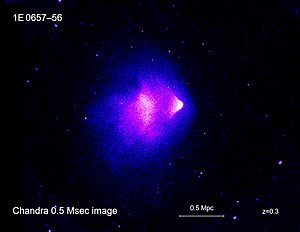Portal:Radiation astronomy/X-ray astronomy article/3

An astrophysical X-ray source is an astronomical object with physical properties which result in the emission of X-rays.
There are a number of types of astrophysical objects which emit X-rays, from galaxy clusters, through black holes in active galactic nuclei (AGN) to galactic objects such as supernova remnants, stars, and binary stars containing a white dwarf (cataclysmic variable stars and super soft X-ray sources), neutron star or black hole (X-ray binaries). Some solar system bodies emit X-rays, the most notable being the Moon, although most of the X-ray brightness of the Moon arises from reflected solar X-rays.
Clusters of galaxies are formed by the merger of smaller units of matter, such as galaxy groups or individual galaxies. The infalling material (which contains galaxies, gas and dark matter) gains kinetic energy as it falls into the cluster's gravitational potential well. The infalling gas collides with gas already in the cluster and is shock heated to between 107 and 108 K depending on the size of the cluster. This very hot gas emits X-rays by thermal bremsstrahlung emission, and spectral line emission from metals (in astronomy, 'metals' often means all elements except hydrogen and helium). The galaxies and dark matter are collisionless and quickly become virialised, orbiting in the cluster potential well.